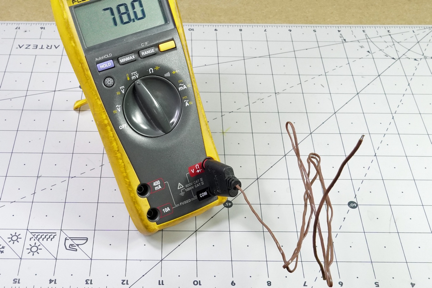Thermocouples sensors are perhaps the most simple and robust electronic temperature sensing devices imaginable. They consist only of two wires made out of dissimilar metals, attached together in a junction, which is placed where the measurement is to be obtained. Thanks to the Seebeck effect—named after German physicist Thomas Seebeck—if there is a temperature differential between the junction of these two wires, and their other measured ends are some distance away, there will be a voltage differential between them.
This voltage differential can be correlated to the actual temperature at the junction, thanks to the Seebeck coefficient, which relates the voltage potential to the temperature. This is often expressed as microvolts per degrees Kelvin (µV/°K), which is equivalent to microvolts per degrees Celsius. If needed, that can be converted to Fahrenheit by dividing by 1.8. While this seems simple enough, several factors are at play here that make the correlation slightly less than straightforward.
Temperature measurement using a thermocouple
While thermocouples can be made from a wide variety of metal combinations, the Seebeck constant varies depending on the construction. This number also changes over the thermocouple usable temperature range, so even if you’re using a standard metal combination, you’ll either need a chart or a mathematical model to correlate the temperature value. You also need to know the temperature at the measurement point, since the voltage is due to the temperature difference, not the absolute temperature itself.
The good news is that standard thermocouple metallurgical combinations are well documented, so if you know the type of thermocouple and are able to measure the temperature at your meter, this can all be worked out. The even better news is that more than likely you don’t even have to do any of that. Electrical meters with thermocouple temperature sensing capabilities are able to automatically correlate this information when the proper probe is used, and can even measure the internal temperature to give an output in actual degrees—not just a temperature difference.
Type K thermocouples and more varieties
Standard thermocouple metal combinations are designated with a letter, such as “type M” or “type T,” and the most common general-purpose thermocouple is known as a “type K.” Type K thermocouples are made from alloys known as chromel and alumel, with a Seebeck coefficient generally pegged at 41µV/°C. This number, of course, varies over its useful measurement range of -200°C to +1350°C.
The type K’s measurement range isn’t unusual, and highlights this class of sensor’s versatility, temperature-wise. Since such a device is simply two wires coupled together, they can be made inexpensively and tend to be quite durable.

Thermocouple plugged into a multimeter for sensing
Disadvantages of thermocouples & other temperature sensors
While widely used, thermocouples do have a few disadvantages beyond the correlation complications noted earlier. Measurements with a precision of under 1°C are difficult to obtain, so they’re not appropriate for some applications. Additionally, as a thermocouple ages, measurements can be thrown off, so they must sometimes be replaced.
In initial testing, my thermocouple (pictured above) read about 80°F in a room that I believed to be closer to 75°F, but which could have actually been a few degrees warmer. As my thermocouple was well over 10 years old, of unknown rating (class 1 thermocouples are spec’d to ± 1.5°C, 2.7°F and class 2 are ± 2.5°C, 4.5°F), and situated next to a window, this number seems reasonable. As with any type of measurement, experimental setup is important, and it’s important to recognize a technology’s limitations.
If a thermocouple doesn’t suit your needs, there are other temperature sensor options that may be appropriate. Thermistor based sensors, for example, can be made accurate to ±.1°C, though these generally have a much more limited measurement range. As another option, infrared sensors have the advantage of being able to produce temperature readings at a distance. Whatever your project or experiment entails, more than likely there is a sensor available that will fit the bill.



